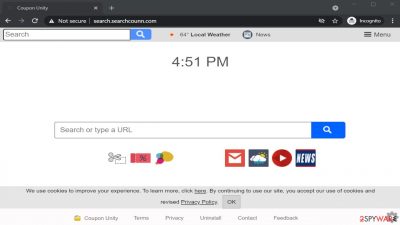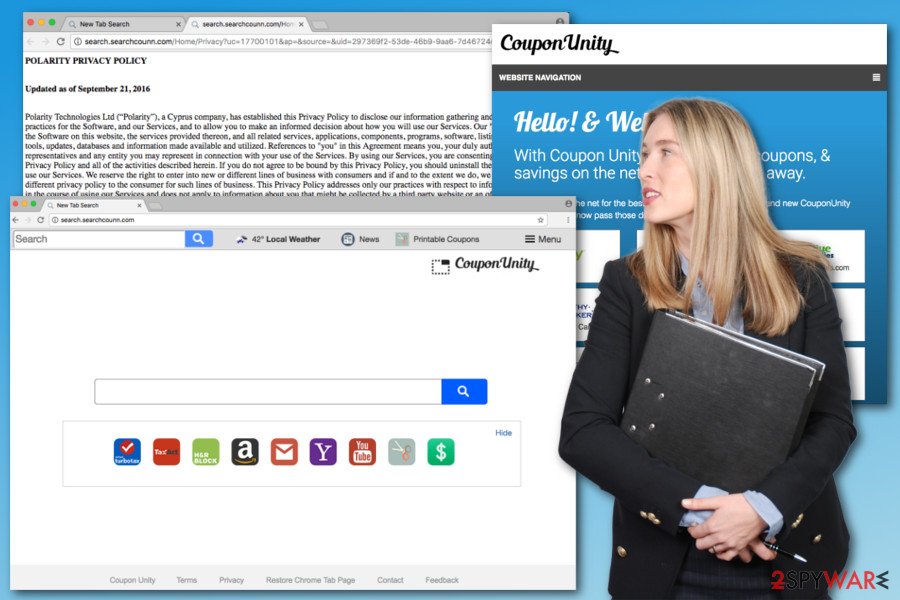Search.searchcounn.com virus - Chrome, Firefox, IE, Edge
Search.searchcounn.com virus Removal Guide
What is Search.searchcounn.com virus?
Search.searchcounn.com – a search engine that you should not trust

Search.searchcounn.com virus is an annoying browser hijacker[1] that might suddenly replace your current homepage address with an unknown search engine. This suspicious search tool might be installed along with other freeware or CouponUnity application.
These two apps are closely related. The search engine's main page includes a toolbar with links to various discount coupon providers and offers quick access to the email services and other websites. However, neither these links nor a search engine is worth using and relying on.
Search.searchcounn.com browser hijacker was developed and distributed by the two shady developers of potentially unwanted programs – Eightpoint Technologies Ltd and Polarity Technologies Ltd. Similar search tools have already hijacked thousands of web browsers and forced users to browse through insecure commercial content.
Thus, if you do not want to be redirected to an infected website, click on a malware-laden ad,[2] or tricked into installing rough software, remove the article's culprit immediately. To help you with that, we're going to explain two of the best options for doing that.
| name | Search.searchcounn.com virus |
|---|---|
| Type | Potentially unwanted program, browser hijacker |
| Associated extensions | CouponUnity |
| Symptoms | Apart from the altered browser preferences (default search engine, new tab, homepage), users have also reported redirects to high-risk sites, diminished PC performance |
| Risks | Malware infections, PUP installation, privacy issues, monetary losses |
| Distribution | Fake Flash Player updates, software bundling |
| Elimination | Remove this browser intruder with reliable anti-malware software that will do the trick automatically |
| System fix | Use the FortectIntego app to get rid of tracking cookies and repair virus damage |
After Search.searchcounn.com hijack, the affected browser’s settings are altered. This search tool might replace the current homepage, default search engine, and new tab URL address. These modifications are needed to keep this search tool as long as possible on the affected PC. Browser hijackers are used as marketing tools.
Thus, developers generate revenue from clicks on the ads and boosted traffic to the sponsored websites. We want to point out that developers do not take responsibility for third-party content and what might happen to you on the affiliate’s website. Also, one of the main problems is related to not being able to find helpful information.
Using this search tool, you might enter an infected or misleading website where you can suffer from various cybercrimes.[3] Although redirects are quite a considerable threat to your computer, this potentially unwanted program might also lead to privacy-related issues.
In the Privacy Policy, developers inform about data collection and usage. They mainly track non-personally identifiable information which might be shared or sold to third parties, business partners, or advertising networks. There’s no doubt that aggregated data is used for marketing purposes,[4] you cannot be sure what might happen if details about you end up in the hands of cybercriminals.
However, Search.searchcounn.com removal will protect you and your computer from all possible damage. To accomplish it properly, use trustworthy software such as SpyHunter 5Combo Cleaner or Malwarebytes. If you're eager to do it yourself, at least use our step-by-step instructions at the bottom of the article. After the removal, use the FortectIntego to fix any system irregularities.

When did the hijack occur?
Search.searchcounn.com virus does not spread or attack computers alone. It belongs to the group of potentially unwanted programs (PUP) that need permission to enter the system. Just like regular software, PUPs cannot be installed without the user’s approval. The tricky part here is that these apps can get indirect permission to enter the system.
This browser hijacker is attached to the software packages.[5] Thus, when installing new programs downloaded from the Internet, you should always check whether you install a single program or a package. This can be done by using Advanced/Custom installation settings. This installation wizard reveals the list of third-party apps that are offered to download as well.
Also, you might find a pre-selected statement agreeing to change your current search engine. You need to deselect all these offers without consideration. They are barely helpful and might cause more problems in the future. Sadly, the majority of users opt for Quick or Standard settings, which do not disclose additional downloads. As a result, all PUPs are installed secretly.
How can I uninstall Search.searchcounn.com virus from my browser entirely?
The quickest and most effective way to remove Search.searchcounn.com is to scan the computer with security software. Malware removal programs not only detect all hijacker-related components but also might detect other suspicious entries hiding on the system.
There’s a chance that other PUPs were installed on your device too. However, if you do not prefer using additional software, you can follow our prepared manual removal instructions. Please be vigilant. If you leave some suspicious files or apps installed, you might soon experience another hijack.
You may remove virus damage with a help of FortectIntego. SpyHunter 5Combo Cleaner and Malwarebytes are recommended to detect potentially unwanted programs and viruses with all their files and registry entries that are related to them.
Getting rid of Search.searchcounn.com virus. Follow these steps
Uninstall from Windows
The guidelines below will help you to remove any suspicious program from the Windows device. From the list of installed programs, delete all questionable applications that you do not remember installing. They might be related to the browser hijacker.
Instructions for Windows 10/8 machines:
- Enter Control Panel into Windows search box and hit Enter or click on the search result.
- Under Programs, select Uninstall a program.

- From the list, find the entry of the suspicious program.
- Right-click on the application and select Uninstall.
- If User Account Control shows up, click Yes.
- Wait till uninstallation process is complete and click OK.

If you are Windows 7/XP user, proceed with the following instructions:
- Click on Windows Start > Control Panel located on the right pane (if you are Windows XP user, click on Add/Remove Programs).
- In Control Panel, select Programs > Uninstall a program.

- Pick the unwanted application by clicking on it once.
- At the top, click Uninstall/Change.
- In the confirmation prompt, pick Yes.
- Click OK once the removal process is finished.
Delete from macOS
Browser hijackers mainly aim at Windows OS users. However, if your Mac has suffered from this pest, please follow the instructions carefully. You need to find and delete all hijacker-related components.
Remove items from Applications folder:
- From the menu bar, select Go > Applications.
- In the Applications folder, look for all related entries.
- Click on the app and drag it to Trash (or right-click and pick Move to Trash)

To fully remove an unwanted app, you need to access Application Support, LaunchAgents, and LaunchDaemons folders and delete relevant files:
- Select Go > Go to Folder.
- Enter /Library/Application Support and click Go or press Enter.
- In the Application Support folder, look for any dubious entries and then delete them.
- Now enter /Library/LaunchAgents and /Library/LaunchDaemons folders the same way and terminate all the related .plist files.

Remove from Microsoft Edge
Nevertheless, Microsoft Edge is quite a new browser; it can still be hijacked. If your homepage is changed, please follow the instructions to get rid of this suspicious site.
Delete unwanted extensions from MS Edge:
- Select Menu (three horizontal dots at the top-right of the browser window) and pick Extensions.
- From the list, pick the extension and click on the Gear icon.
- Click on Uninstall at the bottom.

Clear cookies and other browser data:
- Click on the Menu (three horizontal dots at the top-right of the browser window) and select Privacy & security.
- Under Clear browsing data, pick Choose what to clear.
- Select everything (apart from passwords, although you might want to include Media licenses as well, if applicable) and click on Clear.

Restore new tab and homepage settings:
- Click the menu icon and choose Settings.
- Then find On startup section.
- Click Disable if you found any suspicious domain.
Reset MS Edge if the above steps did not work:
- Press on Ctrl + Shift + Esc to open Task Manager.
- Click on More details arrow at the bottom of the window.
- Select Details tab.
- Now scroll down and locate every entry with Microsoft Edge name in it. Right-click on each of them and select End Task to stop MS Edge from running.

If this solution failed to help you, you need to use an advanced Edge reset method. Note that you need to backup your data before proceeding.
- Find the following folder on your computer: C:\\Users\\%username%\\AppData\\Local\\Packages\\Microsoft.MicrosoftEdge_8wekyb3d8bbwe.
- Press Ctrl + A on your keyboard to select all folders.
- Right-click on them and pick Delete

- Now right-click on the Start button and pick Windows PowerShell (Admin).
- When the new window opens, copy and paste the following command, and then press Enter:
Get-AppXPackage -AllUsers -Name Microsoft.MicrosoftEdge | Foreach {Add-AppxPackage -DisableDevelopmentMode -Register “$($_.InstallLocation)\\AppXManifest.xml” -Verbose

Instructions for Chromium-based Edge
Delete extensions from MS Edge (Chromium):
- Open Edge and click select Settings > Extensions.
- Delete unwanted extensions by clicking Remove.

Clear cache and site data:
- Click on Menu and go to Settings.
- Select Privacy, search and services.
- Under Clear browsing data, pick Choose what to clear.
- Under Time range, pick All time.
- Select Clear now.

Reset Chromium-based MS Edge:
- Click on Menu and select Settings.
- On the left side, pick Reset settings.
- Select Restore settings to their default values.
- Confirm with Reset.

Remove from Mozilla Firefox (FF)
Make sure that the list of Mozilla extensions hasn't been expanded. If you find CouponUnity or other add-ons developed by Polarity Technologies or Eightpoint Technologies, get rid of them immediately. Also, don't forget to reset the browser's settings in order to set your preferred search engine.
Remove dangerous extensions:
- Open Mozilla Firefox browser and click on the Menu (three horizontal lines at the top-right of the window).
- Select Add-ons.
- In here, select unwanted plugin and click Remove.

Reset the homepage:
- Click three horizontal lines at the top right corner to open the menu.
- Choose Options.
- Under Home options, enter your preferred site that will open every time you newly open the Mozilla Firefox.
Clear cookies and site data:
- Click Menu and pick Settings.
- Go to Privacy & Security section.
- Scroll down to locate Cookies and Site Data.
- Click on Clear Data…
- Select Cookies and Site Data, as well as Cached Web Content and press Clear.

Reset Mozilla Firefox
If clearing the browser as explained above did not help, reset Mozilla Firefox:
- Open Mozilla Firefox browser and click the Menu.
- Go to Help and then choose Troubleshooting Information.

- Under Give Firefox a tune up section, click on Refresh Firefox…
- Once the pop-up shows up, confirm the action by pressing on Refresh Firefox.

Remove from Google Chrome
Go to the list of extensions and uninstall all questionable entries from Google Chrome.
Delete malicious extensions from Google Chrome:
- Open Google Chrome, click on the Menu (three vertical dots at the top-right corner) and select More tools > Extensions.
- In the newly opened window, you will see all the installed extensions. Uninstall all the suspicious plugins that might be related to the unwanted program by clicking Remove.

Clear cache and web data from Chrome:
- Click on Menu and pick Settings.
- Under Privacy and security, select Clear browsing data.
- Select Browsing history, Cookies and other site data, as well as Cached images and files.
- Click Clear data.

Change your homepage:
- Click menu and choose Settings.
- Look for a suspicious site in the On startup section.
- Click on Open a specific or set of pages and click on three dots to find the Remove option.
Reset Google Chrome:
If the previous methods did not help you, reset Google Chrome to eliminate all the unwanted components:
- Click on Menu and select Settings.
- In the Settings, scroll down and click Advanced.
- Scroll down and locate Reset and clean up section.
- Now click Restore settings to their original defaults.
- Confirm with Reset settings.

Delete from Safari
Follow the instructions to fix Safari.
Remove unwanted extensions from Safari:
- Click Safari > Preferences…
- In the new window, pick Extensions.
- Select the unwanted extension and select Uninstall.

Clear cookies and other website data from Safari:
- Click Safari > Clear History…
- From the drop-down menu under Clear, pick all history.
- Confirm with Clear History.

Reset Safari if the above-mentioned steps did not help you:
- Click Safari > Preferences…
- Go to Advanced tab.
- Tick the Show Develop menu in menu bar.
- From the menu bar, click Develop, and then select Empty Caches.

After uninstalling this potentially unwanted program (PUP) and fixing each of your web browsers, we recommend you to scan your PC system with a reputable anti-spyware. This will help you to get rid of Search.searchcounn.com registry traces and will also identify related parasites or possible malware infections on your computer. For that you can use our top-rated malware remover: FortectIntego, SpyHunter 5Combo Cleaner or Malwarebytes.
How to prevent from getting browser hijacker
Do not let government spy on you
The government has many issues in regards to tracking users' data and spying on citizens, so you should take this into consideration and learn more about shady information gathering practices. Avoid any unwanted government tracking or spying by going totally anonymous on the internet.
You can choose a different location when you go online and access any material you want without particular content restrictions. You can easily enjoy internet connection without any risks of being hacked by using Private Internet Access VPN.
Control the information that can be accessed by government any other unwanted party and surf online without being spied on. Even if you are not involved in illegal activities or trust your selection of services, platforms, be suspicious for your own security and take precautionary measures by using the VPN service.
Backup files for the later use, in case of the malware attack
Computer users can suffer from data losses due to cyber infections or their own faulty doings. Ransomware can encrypt and hold files hostage, while unforeseen power cuts might cause a loss of important documents. If you have proper up-to-date backups, you can easily recover after such an incident and get back to work. It is also equally important to update backups on a regular basis so that the newest information remains intact – you can set this process to be performed automatically.
When you have the previous version of every important document or project you can avoid frustration and breakdowns. It comes in handy when malware strikes out of nowhere. Use Data Recovery Pro for the data restoration process.
- ^ The Uninvited Guest. A Browser Hijacking Experience, Dissected. Anchor Intellingence. Traffic Quality Solutions.
- ^ Bart Pursel, Ph.D.. Malvertising, the growing problem of malware-laden ads. IST 110. Introduction to Information Sciences and Technology.
- ^ Dan Patterson. 2017 cybercrime trends: Expect a fresh wave of ransomware and IoT hacks. TechRepublic.News, Tips, and Advice for Technology Professionals.
- ^ Peter Eckersley. Online (and What Social Networks Are Doing to Help Them). Electronic Frontier Foundation. Defending Your Rights in the Digital World.
- ^ Bundled software. Webopedia. Online Tech Dictionary for IT Professionals.























